The perfect pound cake is buttery and not overly sweet, with a fine, tender crumb that's rich but not heavy. That's what you'll get from this well-tested recipe.

What is a Pound Cake?
Pound cake is one of those simple, classic desserts that is exactly right for almost every situation from a casual backyard cookouts to fancy dinner parties.
Pound Cake originated in northern Europe during the 18th century, and was aptly named because each of the cake's 4 ingredients - flour, butter, eggs, and sugar - weighed in at a pound each.
This made for a fairly large cake. Today's pound cakes tend to be smaller in size (and weight), and may contain a few other ingredients, while (mostly) maintaining that 1:1:1:1 weight ratio between the flour, butter, eggs, and sugar.

How to Make a Perfect Pound Cake
There are three keys to making a pound cake with a soft, velvety texture, that's dense and buttery but not heavy:
- The reverse creaming method
- A touch of baking powder
- Cake flour
What is the reverse creaming method?
Many cake recipes, including my all-time favorite Vanilla Cake recipe, use a traditional creaming method. With traditional creaming, you start by beating the butter and sugar with an electric mixer until the mixture is light and fluffy.
This causes the sugar crystals to cut through the butter, creating lots of tiny air bubbles that get trapped inside the fat molecules. As the cake bakes, those trapped air bubbles expand, creating a light and fluffy cake.
With reverse creaming, you beat the sugar, butter, AND flour together before adding any of the liquid ingredients. This coats the flour molecules with fat, creating a barrier that slows down the formation of gluten.
Gluten is what gives baked goods structure. If you're baking something like homemade bread you want a strong gluten structure so that the bread has a tight, chewy texture.
But for cake baking, the goal is to combine the ingredients in a way that creates a weak gluten structure, so that the cake has a soft and tender crumb.
Both traditional creaming and reverse creaming will succeed in inhibiting gluten formation. But, the reverse creaming method is more effective in creating the fine, velvety texture that is essential to a really great pound cake.
Does pound cake need baking powder?
Most traditional pound cake recipes rely entirely on eggs to leaven the cake - the "rise" that happens while a cake bakes. And while it's possible to get a soft, tender cake without using any baking powder, it's just as likely that you'll end up with a cake that's dense and grainy. Why take the risk?
In this recipe, I found that just 1 teaspoon of baking powder lightened the texture and insured a good rise while maintaining the dense, rich crumb of a great pound cake.

Why does this recipe call for cake flour?
As we talked about earlier, a weak gluten structure is essential for baking soft, tender cakes. The reverse creaming method does a lot to weaken the gluten structure in pound cake, but there is one more thing we can do to control the amount of gluten in our cake - use a low protein flour.
Cake flour is made from low protein, soft wheat. It is also chlorinated, which makes the flour slightly acidic, weakening the gluten even more.
Chlorination also changes the starch molecules in the flour, allowing them to absorb more liquid and bind better with the fat in the batter. All that results in a cake with a finer, more tender crumb.
Most of the time it's best to just purchase cake flour. But, in a pinch, you can use a combination of flour and cornstarch to create something that's somewhat equivalent to cake flour.
Cake Flour Substitution: For each cup of cake flour in a recipe, remove 2 tablespoons of flour and replace it with 2 tablespoons of cornstarch. Substituting cornstarch for some of the flour will lower the protein content, but not achieve exactly the same results as cake flour since all-purpose flour is not chlorinated.
Extra Egg Yolks are the Secret to Rich and Flavorful Pound Cake
Eggs are one of the most important ingredients in cake recipes because they contribute structure. Proteins in both egg whites and egg yolks coagulate as the cake bakes adding structure to the cake crumb. Without this structure, the cake would just fall apart as soon as you removed it from the pan.
In addition to contributing protein, egg yolks also add fat, flavor, and emulsifying lecithin. Since emulsifiers hold fat and water together, adding extra egg yolks allows the batter to hold more liquid.
That extra liquid, holds more sugar, creating a moister, sweeter, more flavorful cake.

This Is a Mostly Butter Recipe
This recipe is an almost-but-not-quite all-butter pound cake. It contains 16 tablespoons of butter plus 2 tablespoons of vegetable oil.
Adding vegetable oil is a very untraditional way to bake a pound cake, but it's hard to argue with results. Oil is wonderful in cakes. When compared to butter, cakes baked with oil are loftier, have a more even crumb and stay moist and fresh tasting longer.
Butter, on the other hand, contributes flavor and a more dense, sturdy texture. For this recipe, I wanted the best of both.
After trying several different ratios of butter and oil, I found that by replacing just 2 tablespoons of the butter with oil, the cake had a more even crumb, was exceptionally moist, and stayed fresh longer. And, since most of the fat in this recipe is butter, we haven't sacrificed the cake's flavor or structure.
What to Serve with Pound Cake
Pound cake can be served plain, glazed, dusted with powdered sugar, with whipped cream or ice cream, or smothered with butterscotch sauce, whisky sauce, salted caramel, hot fudge sauce, or chocolate ganache.
But my favorite way to eat pound cake is topped with spoonfuls of Maple Brown Butter Roasted Fruit or Cherry Sauce.
Maple Brown Butter Roasted Fruit: Roasting fruit concentrates the natural sugars, intensifying the flavor and sweetness, and softening it up. Add all that to a brown butter maple sauce and you've got the kind of thing dreams are made of.
Cherry Sauce: I make this sauce with fresh cherries all summer long, spooning it over ice cream, cakes, pancakes, waffles, scones, and biscuits. But, you can also use frozen cherries to make it any time of year.
Even better, the sauce requires little more than adding all the ingredients to a saucepan and cooking until it's the consistency of maple syrup.

What Size Loaf Pan Should You Use for this Pound Cake Recipe?
This recipe makes enough batter to fill a standard 9-inch loaf pan. If you use a decorative loaf pan, like the Jubilee Loaf Pan I used for these photos, you might have some batter left over. Most decorated loaf pans don't have quite as much capacity as a standard 9-inch pan.
Whatever size pan you have, fill it no more than ¾ full. If you have batter left over, it means your pan isn't quite the same capacity as a standard loaf pan which will reduce the bake time for your cake.
To ensure a perfectly baked pound cake, check the cake after 55 minutes of baking and then continue to bake, checking it every 5 minutes, until a toothpick inserted in the center of the cake comes out clean.
When done, the top of the cake will appear "set" and it will be pulling away from the sides of the pan ever so slightly.
Leftover batter can be baked into cupcakes. Bake them at 350 degrees for approximately 45 minutes. The baker's treat.
How to Keep Pound Cake From Sticking to the Pan
If you're using a decorative pan with a non-stick coating, spraying it with non-stick baking spray should be enough to keep the cake from sticking. This is good news, because greasing and flouring all those nooks and crannies is a pain in the you-know-what.
Having said that, if you're using a pan that doesn't have a non-stick coating, or if the non-stick coating has worn off a bit, you'll want to grease and flour the pan. Here's how to do that.
If using a standard loaf pan rather than a decorative one, I advise you to also grease and flour the pan - even if it has a non-stick coating. The long, flat surfaces of a standard pan can cause some of the cake to stick to the bottom. It's not 100% necessary, but skipping this step isn't worth the risk.
More Loaf Cake and Single Layer Cake Recipes:
For a super fun Harry Potter-themed take on pound cake, check out this Butterbeer Pound Cake Recipe!
Pound Cake is a Building Block Recipe
Building block recipes are tried-and-true recipes that I consider foundational to great home baking. They are the kind of recipes I come back to over and over again, sometimes baking them as is, but often using them as a jumping off point to create something new. > Scroll through all Building Block recipes.
If you give this recipe a try, let me know! Leave a comment, rate it, or take a picture and tag it #ofbatteranddough on Instagram.
Happy baking!
📖 Recipe
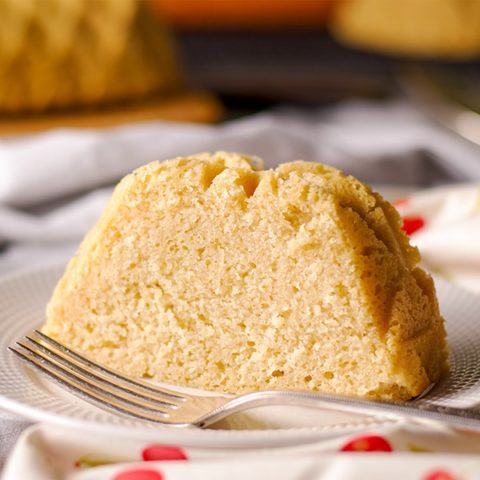
Perfect Pound Cake
The perfect pound cake is buttery and not too sweet, with a tender crumb that's rich but not heavy. That's what you'll get from this well-tested recipe.
Ingredients
- 1 ¾ cups (210g) cake flour (*See note below about making a cake flour substitution)
- ½ teaspoon table salt (¾ teaspoon kosher salt)
- 1 teaspoon baking powder
- 1 ⅓ cups (264g) granulated sugar
- 1 cup (8oz/ 226g) salted butter
- 2 tablespoon (30ml) vegetable or canola oil
- 3 large eggs + 4 large egg yolks
- ¼ cup (59ml) whole milk
- 3 teaspoon pure vanilla extract
- 1 teaspoon almond extract (optional, but recommended)
Serving Suggestions:
Instructions
Make the Cake:
- Heat oven to 350 degrees F (176 degrees C). If using a standard 9-inch loaf pan, grease and flour the pan. If using a decorative non-stick loaf pan, spray the inside of the pan with non-stick baking spray. (*See note below)
- Add the flour, salt, and baking powder to the bowl of an elecric mixer and stir with a wire whisk to combine. Add the sugar and stir to combine.
- Add the butter and oil to the mixing bowl and, using the paddle attachment, beat on medium-low speed for about a minute, until all the dry ingredients are coated with the butter. Turn the mixer to medium high and beat for 3 minutes, stopping to scrape down the sides of the mixing bowl a time or two.
- In a seperate bowl or large measuring cup, add the eggs, egg yolks, milk, and vanilla and almond extracts. Whisk with a fork to combine. Add this mixture to the butter-flour mixture in three additions, beading on medium-low speed after each addition just until incorporated. Stop to scrape down the sides of the bowl inbetween each addition and be careful to not over beat.
- Give the batter a stir with a wooden spoon or rubber spatuala just to make sure all the ingredients are combined. Scrape the batter into the prepared loaf pan, filling it no more than ¾ full. If you are using a loaf pan that is slightly smaller than a standard 9-inch pan, you'll have some batter left over. If you have leftover batter, use it to make a couple of cupcakes. Bake cupcakes at 350 degrees F (176 degrees C) for approximatly 45 minutes.
- Bake the cake for 55 - 75 minutes (*see note below). The cake is done when a toothpick inserted in the center of the cake comes out without any sign of raw batter. Let the cake cool in the pan for about 5 minutes. If using a standard loaf pan (non-decorative), run a knife around the edges of the cake to loosen it. Then flip the cake out onto a wire rack and let it cool completely before slicing and serving.
Notes
What if you don't have cake flour?
To make a substition for cake flour: Measure out 1 ¾ cups of all-purpose flour. Remove 3 tablespons of the flour and add 3 tablespoons of cornstarch.
How to keep your cake from sticking to the pan:
If you're using a decorative pan with a non-stick coating, spraying it with non-stick baking spray should be enough to keep the cake from sticking. If you're using a pan that doesn't have a non-stick coating, or if the non-stick coating has worn off a bit, you'll want to grease and flour the pan. If using a standard loaf pan, non-decorative, I advise you to also grease and flour the pan, even if it has a non-stick coating. The long, flat surfaces of a standard pan can cause some of the cake to stick to the bottom.
Why does this recipe have such a wide range for the bake time?
The wide range in bake time is to account for different sized loaf pans. If you are using a standard, 9-inch loaf pan, your cake will take 75-80 minutes to bake.
If you are baking in a slightly smaller fluted pan (like the cake featured in the photos for this recipe), your cake will bake in approximatly 55 minutes. Just keep an eye on it.
The cake will be set on top and starting to pull away from the sides of the pan when it's done. To test it, stick a toothpick in the center of the cake and pull it out. If there is no evidence of raw batter on the toothpick, the cake is done baking.
How long will this pound cake keep?
The cake can be prepared up to 2 days in advance, wrapped tighly with plastic wrap, and stored at room temperature. It can also be frozen for up to 3 months. To freeze, wrap it in a couple layers of plastic wrap then wrap it in aluminum foil.
Recommended Products
As an Amazon Associate and member of other affiliate programs, I earn from qualifying purchases.
Nutrition Information:
Yield: 8 Serving Size: ⅛th of a 9-inch loaf cakeAmount Per Serving: Calories: 561Total Fat: 31gSaturated Fat: 17gTrans Fat: 1gUnsaturated Fat: 12gCholesterol: 251mgSodium: 468mgCarbohydrates: 61gFiber: 1gSugar: 36gProtein: 9g
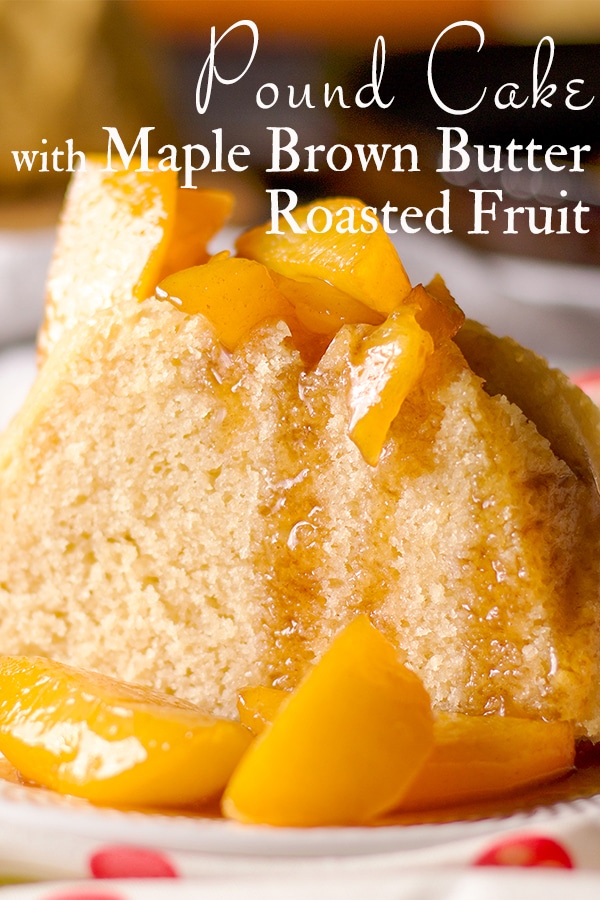







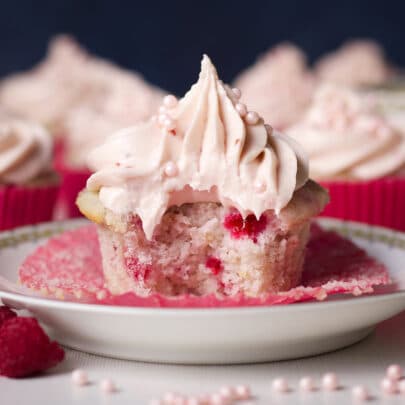
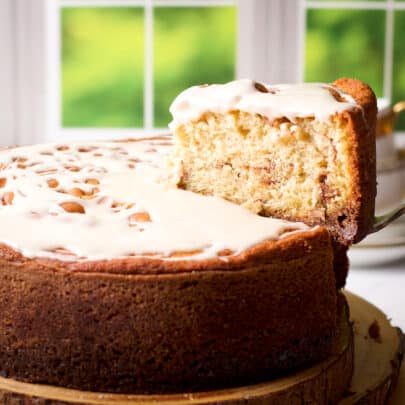
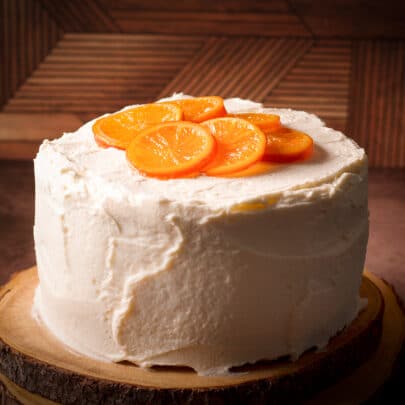
Carla Luan says
Would this produce enough batter to bake the cake in a traditional bundt cake pan? If so, what temperature should I use and for how long? Looks fantastic and I want to try it! Thanks!!
Rebecca Blackwell says
Hi Carla! If you have a 9 or 10 inch bundt pan, this recipe will give you enough batter to bake a pound cake that's on the short side, but it will work! Typically, you want about 6 - 7 cups of batter for a 9 or 10 inch bundt pan. This recipe makes approximately 4 cups of batter, so you'll just end up with a shorter cake - which will still look and taste delicious. 🙂 Because it's the same amount of batter as a loaf cake, the bake temperature and time should stay the same.
You can also make a recipe and a half, which will give you the right amount of batter to make a taller bundt cake. Keep the batter at least 1 1/4 inch below the top of the pan to ensure it won't overflow while it bakes. (use 5 whole eggs plus 5 egg yolks) In this case, you'll be baking a cake with more batter, so the bake time will be longer. I would actually suggest baking it at 325 degrees, and I believe it will take between 75 and 95 minutes. If the top is getting too brown, cover it loosely with a piece of aluminum foil.
I hope that helps! As always, please let me know if you have any other questions! And, I'd love to hear how this works out for you! xo
Carla Luan says
Thank you so much! You're so great about answering. I'll send a pic!
Erin says
Oooh, interesting! I didn't know that about the origins of pound cake. That indeed sounds like a heavy cake. 😀 Yours looks incredible with a great texture!
Rebecca Blackwell says
Thanks so much Erin! I'd love to know what you think of this cake if you make it. Thanks so much for taking the time to leave a comment for me! xo
Christine says
This looks incredible! Any other toppings you would suggest?
Rebecca Blackwell says
Vanilla ice cream, hot fudge, caramel sauce, butterscotch sauce, whipped cream, powdered sugar, ice cream, pudding, fresh fruit, jam... anything your heart desires. xo
Karen says
Hi Rebecca - Great tip on reverse creaming. I've worked as a professional pastry chef and never tried it! Pound cake is one of our faves and can't wait to make your recipe.
Rebecca Blackwell says
Thanks Karen! I can't wait to hear what you think of this cake! Thanks so much for taking the time to leave a comment for me! xo